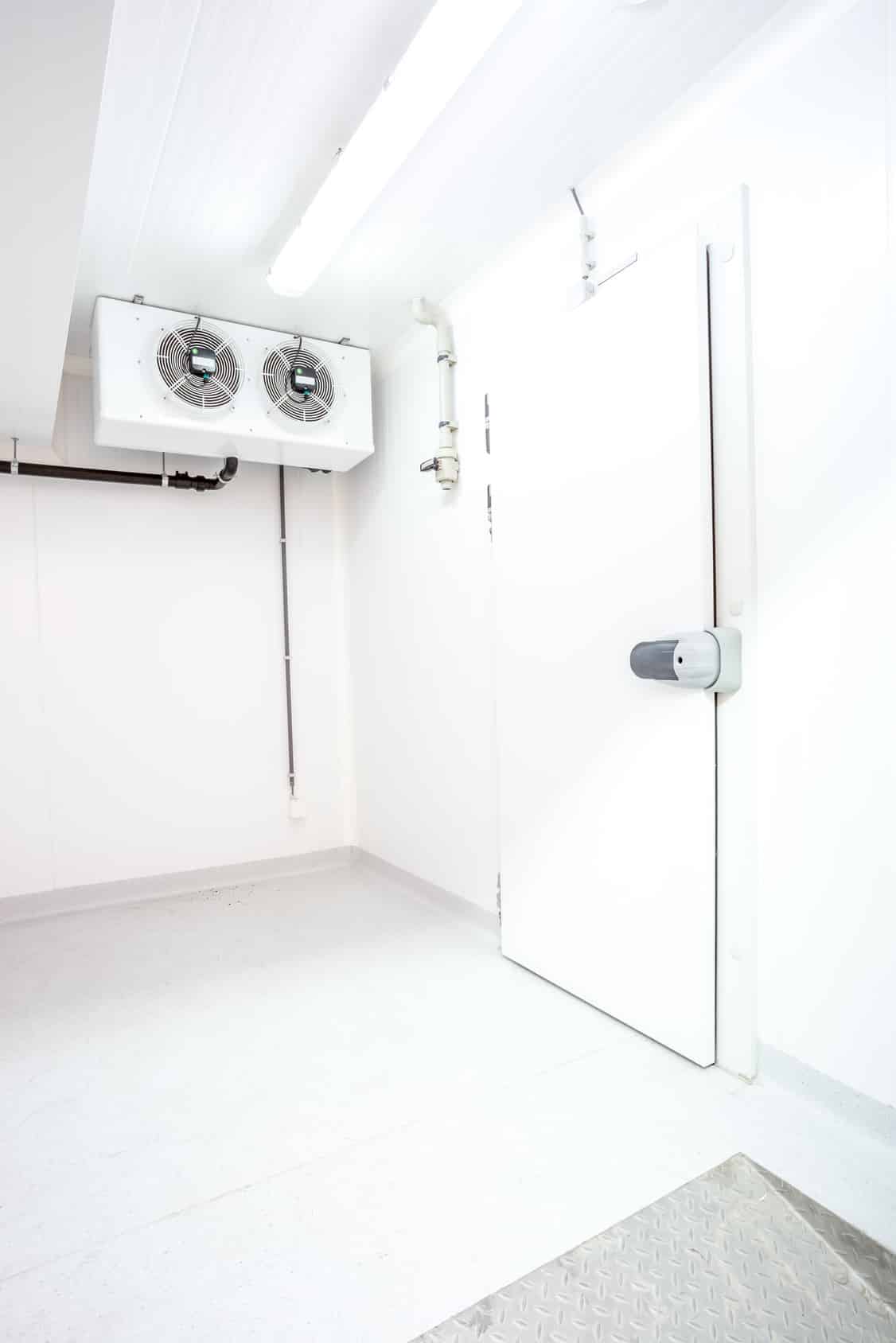Thermal Inspection of Refrigerated Warehouses
The use of non-destructive infrared imaging of a refrigerated warehouse provides an invaluable diagnostic tool. The presence of any type of breach in the box can create havoc with the refrigeration system. As the system works to remove heat from the cooler, the uncontrolled addition of ambient air can cause a number of problems including energy consumption, product loss, and thermal envelope damage.
The information presented below is from a Technical Paper written by one of our Company’s Founders, Phil McMullan.
HOW DOES A REFRIGERATION SYSTEM WORK?
Commercial refrigeration is similar to home refrigeration. Refrigeration is the process of removing heat from an area and transferring it somewhere else. The refrigeration process only works because of the mechanical systems involved and the thermal envelope that seals the areas. The sealed off area is often referred to as the refrigerated box, it’s critical in low and medium temperature applications.
Medium temperature refrigeration typically ranges from 28 degrees F to 40 degrees F with most operating at just above freezing, 32 degrees F. A home refrigerator’s fresh food compartment is a good example of medium temperature refrigeration. Low temperature refrigeration produces temperatures below freezing. Temperatures can range from just under 32 degrees F, such as in making ice. Low temperature food storage which generally starts at 0 degrees F to as low as –20 degrees F. Frozen meats, vegetables, and dairy products are items preserved by low temperature refrigeration. Extra low temperature facilities used to fast freeze will reach temperatures of –50F.
REFRIGERATED WAREHOUSE DESIGN
There are two primary components required in the refrigeration process. Shown in figure 1 is a typical mechanical refrigeration system, similar to the ones seen in the facilities, which are discussed in this paper. This two-stage compressor system is designed to cool a freezer for extra low temperature refrigeration with product temperatures as low as minus 50 degrees F. If the application were medium or simply low temperature a single stage compressor would be employed. Regardless of the application, the purpose of this system is to collect the heat within the refrigerated area and remove it to outside the area. It is important to note that the size of the refrigeration system is based on a number of factors. These factors include building design, indoor and outdoor temperatures, and the type and flow of goods expected. Warehouse locations that are subject to high humidity, warm temperatures or manual product handling may dramatically effect the design of the facility.
The thermal envelope is of critical importance in low and medium-temperature applications. There are four factors of refrigeration load associated with the building envelope. These are transmission losses, infiltration, internal operations loads and cooling of goods received.
Transmission losses involve sensible heat gain through walls, floor and ceiling. These are components that readily lend themselves to infrared inspection. Air infiltration heat gain can occur from several sources, primarily direct in-flow from portions of the building envelope which are not sealed and from passageways. Figure 3 shows what occurs when a freezer door is open.
THERMOGRAPHIC INSPECTION
The inspection of a medium temperature beverage warehouse and a low temperature commercial food freezer are the subjects of this testing information. The following testing was completed on the building envelope of these buildings.
An infrared thermographic inspection on the exterior walls and ceiling/roof was conducted from the interior and exterior, where possible, of the refrigerator building envelopes. The purpose of this inspection is to document heat loss/gain, as well as other thermal anomalies in the building envelope that might be associated with excessive moisture and/or air infiltration in the walls and ceiling of the facility. In the case of the beverage warehouse, this imaging was done both before and after the
depressurization of the cooler, with the refrigeration units turned off.
Pressure measurements of the subject building area in the normal operating mode between the inside and outside of the refrigerated area as well as between medium temperature cooler, low temperature cold storage and other adjacent areas. Depressurization of the beverage cooler envelope utilizing the fan depressurization method to measure the number of air changes per hour within the cooler and to assist the infrared camera to locate those areas of the envelope, which are leaking
air. Temperature and humidity level measurement before, after and during the testing of the envelope. Neutron thermalization moisture testing on the low slope roof areas. This test measures the location and amount of moisture trapped within the roofing system.
These building envelope inspections are based on non-destructive instrumented inspections, visual inspection, interviews and a review of available construction documents.
FINDINGS
All pertinent weather data was recorded for each day of the inspection. The buildings operating temperatures were recorded for the areas, which were part of the inspection. Building operating pressure was measured on all possible elevations of the building.
The following is a list of the findings from these two types of refrigerated facilities:
Moisture in wall system
Different wall construction types presented different amounts of wall moisture. The sandwich panel construction had more problems with moisture infiltration. The beverage warehouse which used stick built wall construction resulted in no areas of above normal moisture found in the wall sections tested. All testing showed a very even thermal pattern throughout the wall sections. The junction of the wall and ceiling shows a significant heat gain under normal conditions and a dramatic temperature rise during depressurization. It appears that this situation is creating the moisture that is running down the walls and staining the interior wall panels. This situation also occurred in the commercial freezer.
Operating at a negative pressure
This is the situation in all refrigerated spaces which are not 100% sealed, and no facility I have inspected achieved that level of air tightness – product must move through doors and to the loading dock. Keep in mind that the direction of heat flow and vapor flows are from the outside to the refrigerated area. Measurements were taken of the interior static pressure across the envelope with the building in “normal” HVAC operating conditions. The results show negative pressures of 6.4 Pascal to the outside and a negative 4.2 Pascal between the medium and low-temperature storage area.
Convective losses
With the beverage warehouse, numerous areas of the ceiling were found in which cracks and holes in the upper section of the building envelope are allowing the free movement of outside air into the upper portion of the cooler. This situation is allowing unconditioned outside air to infiltrate the ceiling insulation, reach dew point, condensate and eventually saturate the fiberglass insulation under certain weather conditions. When the cooler was placed in a negative pressure, temperatures at the ceiling area rose from the operating temperature of 45 degrees F to over 70 degrees F. The surface temperatures exceeded the outside air temperature of 97 degrees F at the time of the measurement. It is important to note that the vapor barrier at the ceiling was installed on the cold side (inside) of the envelope. This situation further compounded the moisture problems in the ceiling with the fact that the majority of the air leakage is from above the ceiling and directly into the insulation making these numbers have more of an impact on the operation and performance of the coolers. Figure 11 shows thermograms before depressurization of facility (left) and after depressurization of facility (right).
Conductive losses
The facilities inspected presented a number of different conductive loss patterns. All of the patterns are typical of this type of construction. The most significant area of loss is again the ceiling on the beverage warehouse where the thermal resistance of the cooler envelope is considerably less than at the walls. In the commercial freezer, the moisture damaged wall panels and panel seams provided the majority of the conductive losses.
SUMMARY
After reviewing the test data it appears that conductive heat gains, excess air infiltration, and increased humidity levels are present in these buildings. This situation is making it difficult for the refrigeration units to keep up with the load and adjustments to these units. After uncontrolled air infiltration has been eliminated and moisture damaged insulation has been repaired; the changes may need to be re-examined for their performance and necessity.
Significant benefits can be achieved in the functional performance of refrigerated spaces with the use of thermal imaging in conjunction with normal refrigerated system maintenance on a routine basis. Potential problems can be identified prior to becoming serious. The result will be lowered maintenance and operating costs for refrigerated facilities.
REFERENCES
ASHRAE Handbook, 1993, “Fundamentals” Atlanta, GA; American Society of Heating, Refrigerating and Air Conditioning
Engineers, Inc.
ASHRAE Handbook, 1994, “Refrigeration Systems and Application” Atlanta, GA; American Society of Heating,
Refrigerating and Air Conditioning Engineers, Inc.
William C. Whitman, 1995, “Refrigeration & Air Conditioning Technology”, Delmar Publishers, Albany, NY







